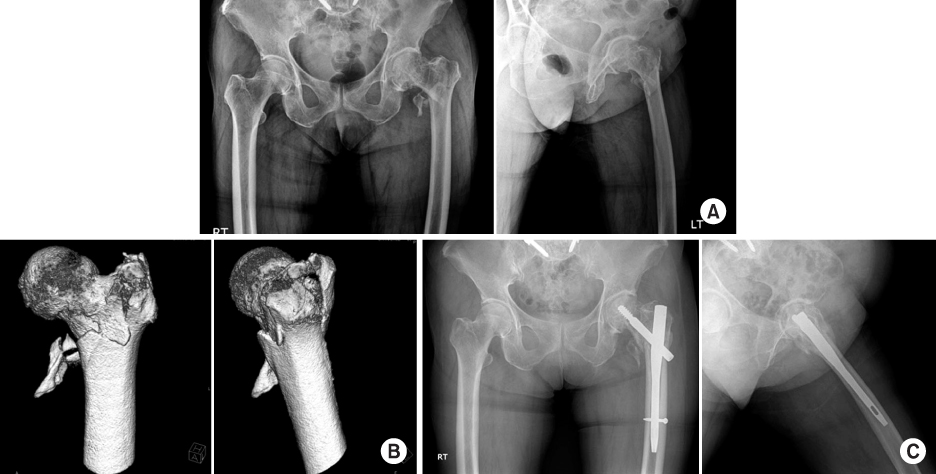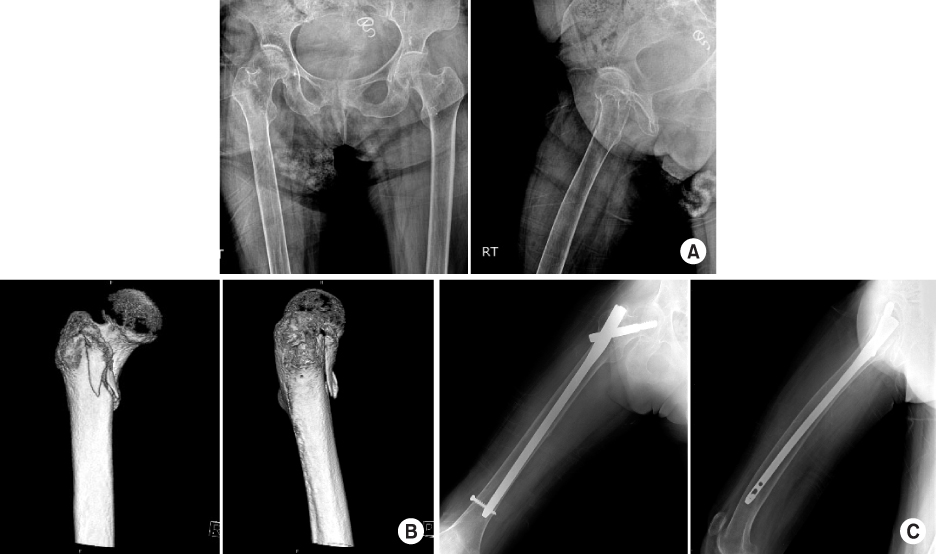J Korean Fract Soc.
2014 Jan;27(1):36-41. 10.12671/jkfs.2014.27.1.36.
Unstable Intertrochanteric Fracture Treated with ITST: A Comparative Study between Groups with and without Comminution of Greater Trochanter
- Affiliations
-
- 1Department of Orthopedic Surgery, Gwangmyeong Sungae Hospital, Gwangmyeong, Korea. hsh315@naver.com
- KMID: 1817000
- DOI: http://doi.org/10.12671/jkfs.2014.27.1.36
Abstract
- PURPOSE
To evaluate whether the radiological and clinical results of treatment with intertrochanteric/subtrochanteric (ITST) nail on unstable intertrochanteric fractures are combined with comminution of the greater trochanter or not.
MATERIALS AND METHODS
We reviewed the results on 210 cases of unstable intertrochanteric fractures (grouped 88 patients with comminution of greater trochanter [GT] and 122 patients without comminution of GT) treated with ITST nail from January 2007 to October 2011, which was to be followed-up for more than 12 months.
RESULTS
The mean union time was 15.2 weeks in the study group (combined with comminution of GT). The mean union time was 14.7 weeks in control group (no comminution of GT). The lag screw sliding was 8.7 mm in the study group and 7.2 mm in the control group. Changes of neck-shaft angle was 4.2degrees in study group and 4.1degrees in control group. Tip-apex distance was 17.4 mm in study group and 16.4 mm in control group. The complications were 4 cases in each study group and control group. The clinical results checked by Skovron recovery scores decreased similarly in both groups, 73.7% in study group and 76.5% in control group. There were no significant differences in both groups according to radiological and clinical results.
CONCLUSION
The comminution of great trochanter does not affect on the radiological and clinical results when using the ITST nail of unstable intertrochanteric fractures.
Keyword
MeSH Terms
Figure
Reference
-
1. Boriani S, Bettelli G, Zmerly H, et al. Results of the multicentric Italian experience on the Gamma nail: a report on 648 cases. Orthopedics. 1991; 14:1307–1314.
Article2. Bridle SH, Patel AD, Bircher M, Calvert PT. Fixation of intertrochanteric fractures of the femur. A randomised prospective comparison of the gamma nail and the dynamic hip screw. J Bone Joint Surg Br. 1991; 73:330–334.
Article3. Brink PR, Bolhuis RJ, Runne WC, De Vries AC. Low nail-plate fixation and early weight-bearing ambulation for stable trochanteric fractures. J Trauma. 1987; 27:491–495.
Article4. Butt MS, Krikler SJ, Nafie S, Ali MS. Comparison of dynamic hip screw and gamma nail: a prospective, randomized, controlled trial. Injury. 1995; 26:615–618.
Article5. Chang JD, Kim TY, Hwang JH, Min SK, Yoo JH. Analysis of the fixation failure in intertrochanteric hip fractures treated with hip nailing. J Korean Fract Soc. 2012; 25:169–176.
Article6. Davis J, Harris MB, Duval M, D'Ambrosia R. Pertrochanteric fractures treated with the Gamma nail: technique and report of early results. Orthopedics. 1991; 14:939–942.
Article7. Davis TR, Sher JL, Horsman A, Simpson M, Porter BB, Checketts RG. Intertrochanteric femoral fractures. Mechanical failure after internal fixation. J Bone Joint Surg Br. 1990; 72:26–31.
Article8. Dimon JH, Hughston JC. Unstable intertrochanteric fractures of the hip. J Bone Joint Surg Am. 1967; 49:440–450.
Article9. Doherty JH Jr, Lyden JP. Intertrochanteric fractures of the hip treated with the hip compression screw: analysis of problems. Clin Orthop Relat Res. 1979; (141):184–187.10. Evans EM. The treatment of trochanteric fractures of the femur. J Bone Joint Surg Br. 1949; 31B:190–203.
Article11. Geller JA, Saifi C, Morrison TA, Macaulay W. Tip-apex distance of intramedullary devices as a predictor of cut-out failure in the treatment of peritrochanteric elderly hip fractures. Int Orthop. 2010; 34:719–722.
Article12. Goldhagen PR, O'Connor DR, Schwarze D, Schwartz E. A prospective comparative study of the compression hip screw and the gamma nail. J Orthop Trauma. 1994; 8:367–372.
Article13. Guyton JL. Intertrochanteric fractures of the hip. In : Canale ST, Campbell WC, editors. Campbell's operative orthopaedics. 9th ed. St. Louis: Mosby;1998. p. 2188–2190.14. Halder SC. The Gamma nail for peritrochanteric fractures. J Bone Joint Surg Br. 1992; 74:340–344.
Article15. Jeon HS, Park BM, Song KS, Kim HG, Yun JJ. The comparison between ITST (TM) (intertrochanteric/subtrochanteric) & DHS (dynamic hip screw) in unstable femur intertrochanteric fracture. J Korean Fract Soc. 2009; 22:131–137.
Article16. Kawaguchi S, Sawada K, Nabeta Y. Cutting-out of the lag screw after internal fixation with the Asiatic gamma nail. Injury. 1998; 29:47–53.
Article17. Larsson S, Friberg S, Hansson LI. Trochanteric fractures. Influence of reduction and implant position on impaction and complications. Clin Orthop Relat Res. 1990; (259):130–139.18. Leung KS, So WS, Shen WY, Hui PW. Gamma nails and dynamic hip screws for peritrochanteric fractures. A randomised prospective study in elderly patients. J Bone Joint Surg Br. 1992; 74:345–351.
Article19. Lindsey RW, Teal P, Probe RA, Rhoads D, Davenport S, Schauder K. Early experience with the gamma interlocking nail for peritrochanteric fractures of the proximal femur. J Trauma. 1991; 31:1649–1658.
Article20. Liu M, Yang Z, Pei F, Huang F, Chen S, Xiang Z. A meta-analysis of the Gamma nail and dynamic hip screw in treating peritrochanteric fractures. Int Orthop. 2010; 34:323–328.
Article21. Mahomed N, Harrington I, Kellam J, Maistrelli G, Hearn T, Vroemen J. Biomechanical analysis of the Gamma nail and sliding hip screw. Clin Orthop Relat Res. 1994; (304):280–288.
Article22. Mainds CC, Newman RJ. Implant failures in patients with proximal fractures of the femur treated with a sliding screw device. Injury. 1989; 20:98–100.
Article23. Mulholland RC, Gunn DR. Sliding screw plate fixation of intertrochanteric femoral fractures. J Trauma. 1972; 12:581–591.
Article24. Nishiura T, Nozawa M, Morio H. The new technique of precise insertion of lag screw in an operative treatment of trochanteric femoral fractures with a short intramedullary nail. Injury. 2009; 40:1077–1083.
Article25. Radford PJ, Needoff M, Webb JK. A prospective randomised comparison of the dynamic hip screw and the gamma locking nail. J Bone Joint Surg Br. 1993; 75:789–793.
Article26. Sernbo I, Johnell O, Gentz CF, Nilsson JA. Unstable intertrochanteric fractures of the hip. Treatment with Ender pins compared with a compression hip-screw. J Bone Joint Surg Am. 1988; 70:1297–1303.
Article27. Shin DK, Kwun KW, Kim SK, Lee SW, Choi CH, Kim KM. Proximal Femoral Nail (PFN) for Femur Intertrochanteric Fracture. J Korean Soc Fract. 2002; 15:328–335.
Article28. Shon WY, Park JH, Kil KH, Jeon SJ, Suh SW. Functional recovery after operative treatment of hip fractures in the elderly. J Korean Orthop Assoc. 1998; 33:968–973.
Article
- Full Text Links
- Actions
-
Cited
- CITED
-
- Close
- Share
- Similar articles
-
- Helical Blade versus Lag Screw for Treatment of Intertrochanteric Fracture
- A Comparative Study of Trochanteric Fractures Treated with the Intertrochanteric/subtrochanteric Fixation or the Proximal Femoral Nail
- Changes of the Fracture Fragments of Lesser Trochanter after Operative Treatment in the Unstable Femoral Intertrochanteric Fractures
- Methods to Increase the Effectiveness of Trochanteric Stabilizing Plate for Unstable Femoral Intertrochanteric Fractures with Gtreater Trochanteric Fracture: Fixation of Greater Trochanter with Wire and Screw
- The Comparison between ITST(TM) (Intertrochanteric/Subtrochanteric) & DHS (Dynamic Hip Screw) in Unstable Femur Intertrochanteric Fracture



